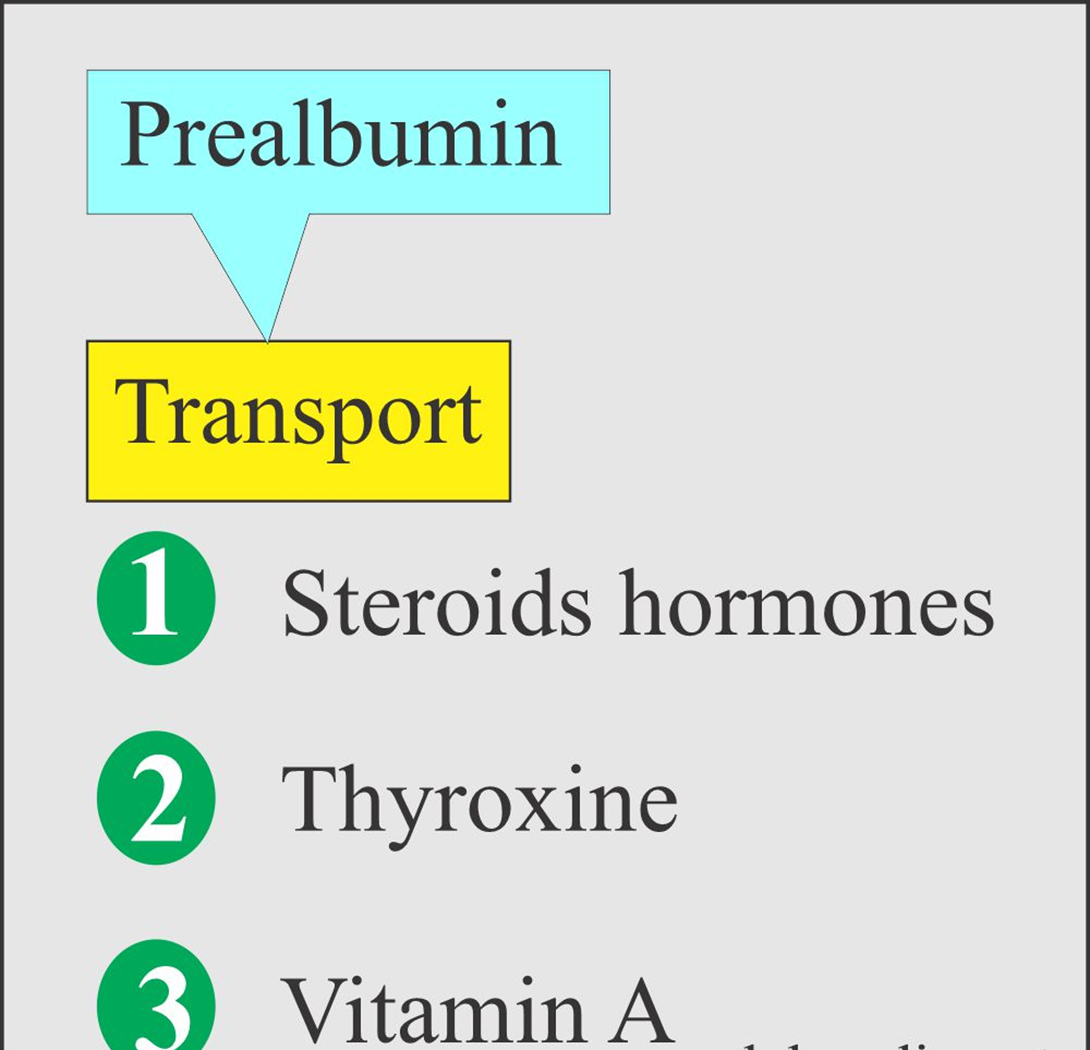A nurse is caring for a client who has a major burn injury and is receiving total parenteral nutrition. Which of the following laboratory tests is the priority for the nurse to use to confirm the client is receiving adequate nutrition?
Prealbumin
Folic acid
Magnesium
Transferrin
The Correct Answer is A
Choice A reason: Prealbumin is a protein that is synthesized by the liver and reflects the current nutritional status of the client. It has a short half-life of 2 to 3 days, which makes it a sensitive indicator of changes in protein intake. Prealbumin levels are decreased in clients who are malnourished or have inflammation, infection, or liver disease. The nurse should monitor the prealbumin levels of the client who is receiving total parenteral nutrition to ensure that they are within the normal range of 15 to 36 mg/dL.
Choice B reason: Folic acid is a water-soluble vitamin that is involved in DNA synthesis, cell division, and red blood cell production. Folic acid levels are decreased in clients who have malabsorption, alcoholism, or certain medications, such as methotrexate or phenytoin. The nurse should assess the folic acid levels of the client who is receiving total parenteral nutrition, but it is not the priority test to confirm adequate nutrition.
Choice C reason: Magnesium is a mineral that is involved in many enzymatic reactions, muscle contraction, nerve transmission, and bone formation. Magnesium levels are decreased in clients who have malnutrition, diarrhea, vomiting, or diuretic use. The nurse should evaluate the magnesium levels of the client who is receiving total parenteral nutrition, but it is not the priority test to confirm adequate nutrition.
Choice D reason: Transferrin is a protein that transports iron in the blood and reflects the iron stores of the client. Transferrin levels are decreased in clients who have iron deficiency anemia, chronic disease, or liver disease. The nurse should check the transferrin levels of the client who is receiving total parenteral nutrition, but it is not the priority test to confirm adequate nutrition.

Nursing Test Bank
Naxlex Comprehensive Predictor Exams
Related Questions
Correct Answer is D
Explanation
Choice A reason: Crohn's disease is not commonly associated with obesity, although obesity can worsen the symptoms and complications of Crohn's disease. Crohn's disease is a type of inflammatory bowel disease that causes inflammation and ulcers in the digestive tract, especially the small intestine and colon. The exact cause of Crohn's disease is unknown, but it may involve genetic, immune, and environmental factors.
Choice B reason: Celiac disease is not commonly associated with obesity, although obesity can make the diagnosis of celiac disease more difficult. Celiac disease is an autoimmune disorder that causes damage to the small intestine when gluten, a protein found in wheat, barley, and rye, is ingested. The damage interferes with the absorption of nutrients and can lead to malnutrition, anemia, and osteoporosis.
Choice C reason: Peptic ulcer disease is not commonly associated with obesity, although obesity can increase the risk of complications from peptic ulcer disease. Peptic ulcer disease is a condition that causes sores or ulcers in the lining of the stomach or duodenum, the first part of the small intestine. The most common causes of peptic ulcer disease are infection with Helicobacter pylori bacteria and use of nonsteroidal anti-inflammatory drugs (NSAIDs).
Choice D reason: Gastroesophageal reflux disease (GERD) is commonly associated with obesity, as obesity can increase the pressure on the lower esophageal sphincter (LES), the muscle that prevents the backflow of stomach acid into the esophagus. GERD is a condition that causes heartburn, regurgitation, chest pain, and difficulty swallowing due to the reflux of stomach acid into the esophagus. GERD can also lead to esophagitis, Barrett's esophagus, and esophageal cancer.
Correct Answer is D
Explanation
Choice A reason: Increasing the caloric intake before pregnancy is not an appropriate dietary guideline, as it can lead to excessive weight gain and obesity, which can increase the risk of gestational diabetes, hypertension, and other complications. The nurse should advise the client to maintain a healthy weight and a balanced diet before and during pregnancy.
Choice B reason: Increasing the total intake of seafood to 20 ounces per week is not an appropriate dietary guideline, as it can expose the client to high levels of mercury, which can harm the developing fetus. The nurse should advise the client to limit the intake of seafood to 8 to 12 ounces per week, and avoid fish that are high in mercury, such as shark, swordfish, and king mackerel.
Choice C reason: Decreasing ascorbic acid in the diet is not an appropriate dietary guideline, as it can impair the immune system and the absorption of iron, which are both important for the health of the mother and the fetus. The nurse should advise the client to consume adequate amounts of ascorbic acid, which is found in citrus fruits, tomatoes, broccoli, and other foods.
Choice D reason: Increasing folic acid to 400 micrograms per day prior to getting pregnant is an appropriate dietary guideline, as it can prevent neural tube defects, such as spina bifida and anencephaly, in the fetus. The nurse should advise the client to take a daily prenatal vitamin that contains folic acid, and eat foods that are rich in folate, such as leafy greens, beans, and fortified cereals.
Whether you are a student looking to ace your exams or a practicing nurse seeking to enhance your expertise , our nursing education contents will empower you with the confidence and competence to make a difference in the lives of patients and become a respected leader in the healthcare field.
Visit Naxlex, invest in your future and unlock endless possibilities with our unparalleled nursing education contents today
Report Wrong Answer on the Current Question
Do you disagree with the answer? If yes, what is your expected answer? Explain.
Kindly be descriptive with the issue you are facing.
